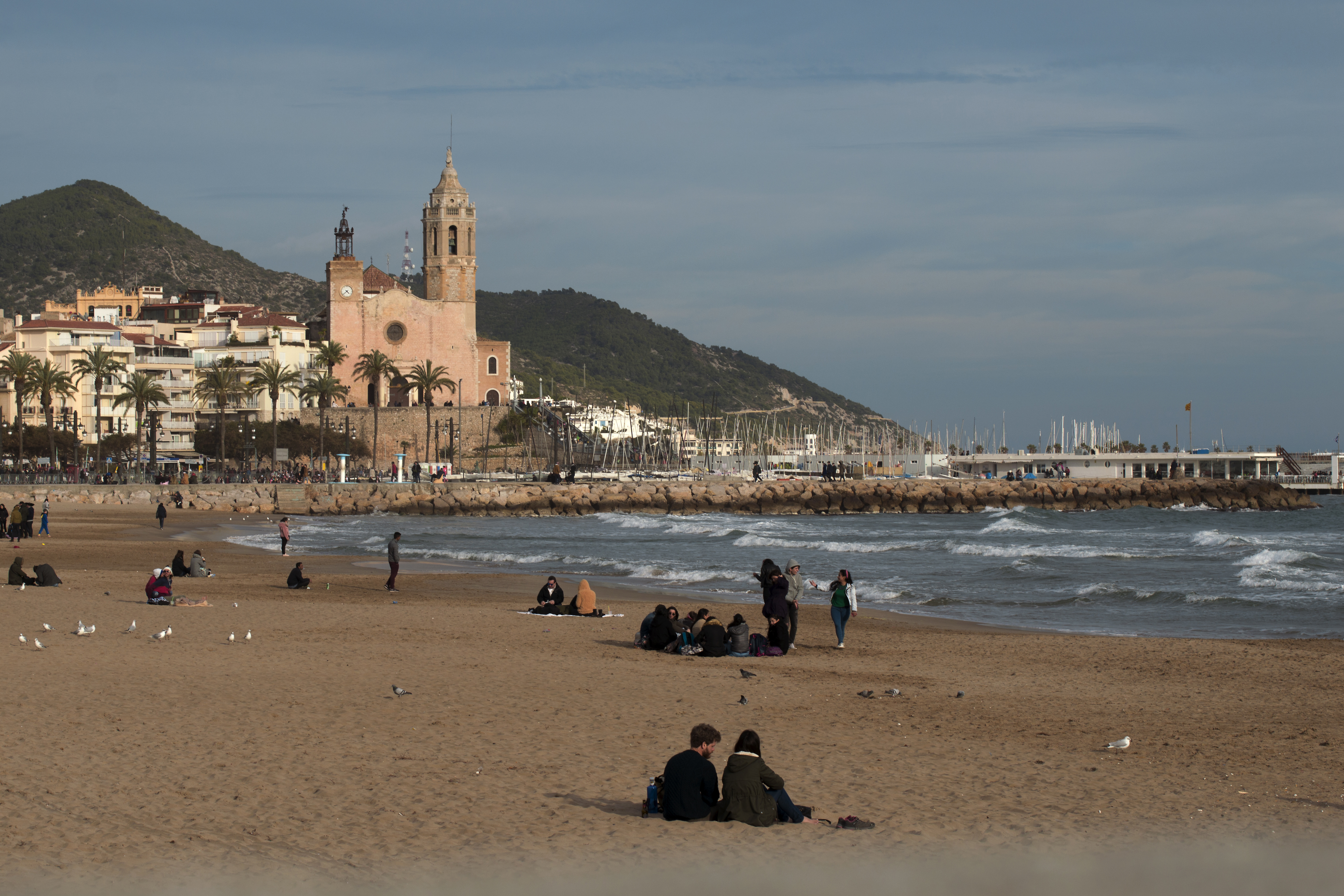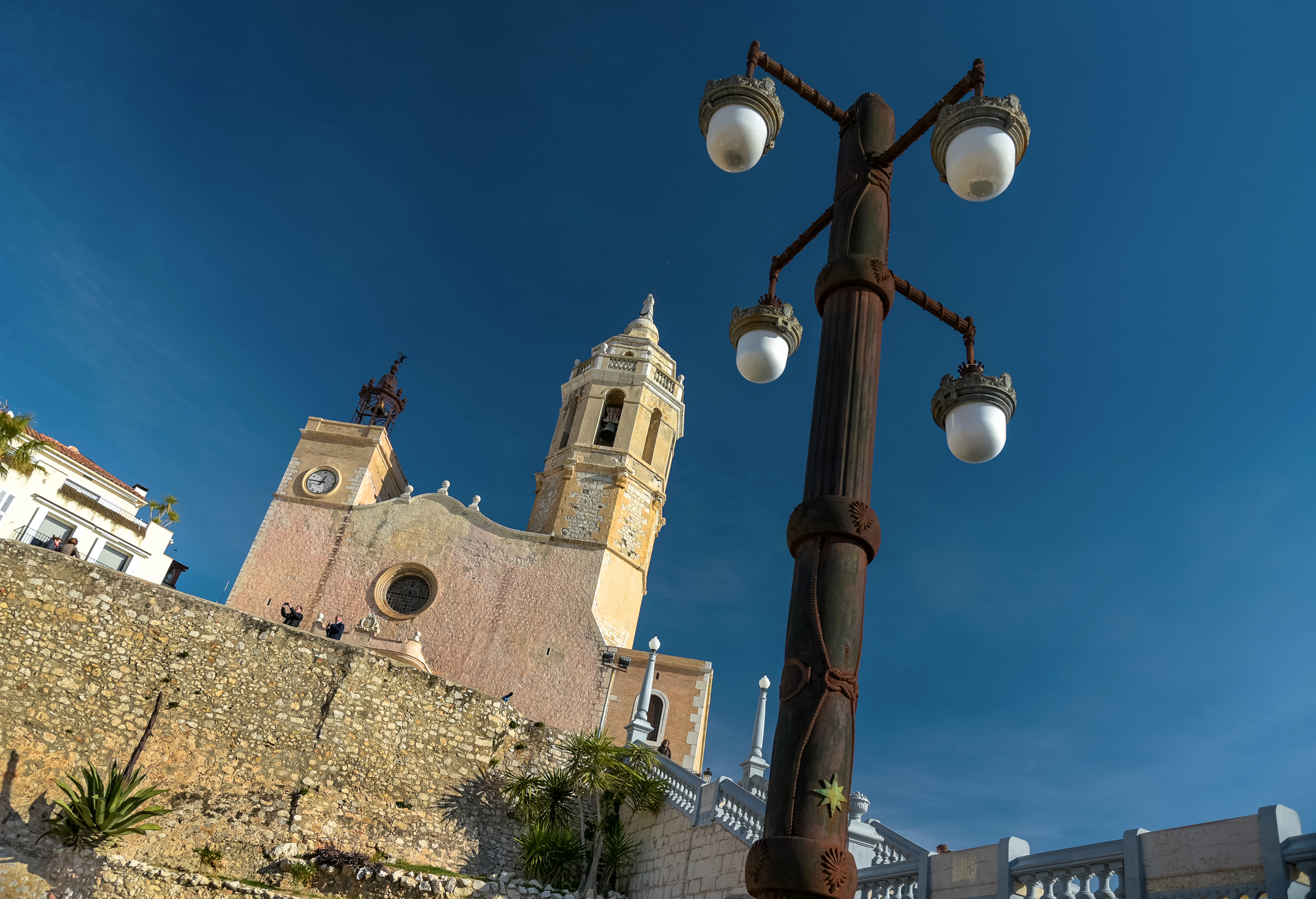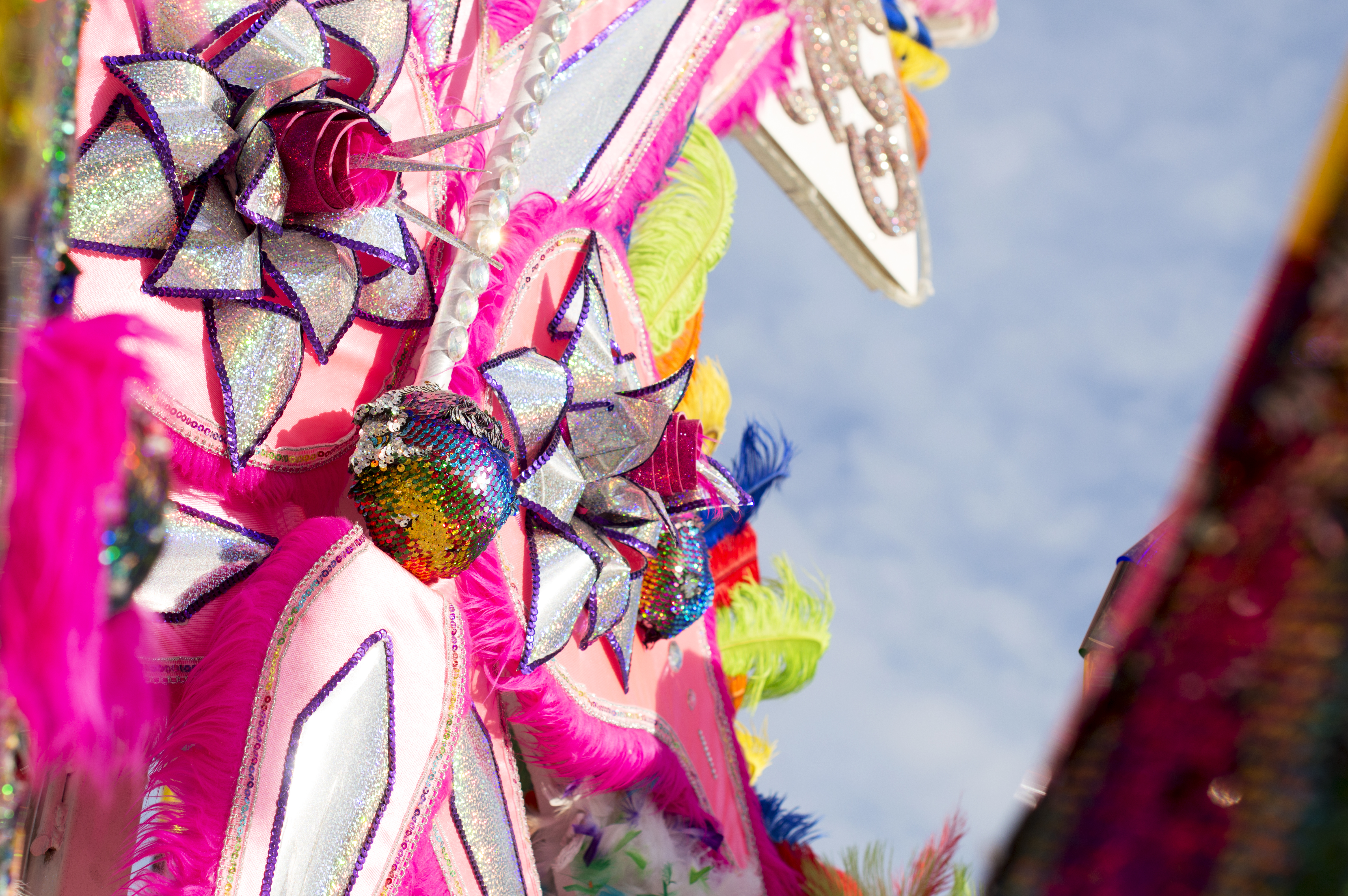Escaping from the crowded streets of Barcelona, Sitges is an intimate retreat from city life. Nestled south along the coast the seaside town has a vibrant nightlife and festival scene, which those not native to Spain might find unexpected. Here, the rocky coast disintegrates into vast sandy beaches washed by calm waves and salt-sprayed air.

Sitges’s beaches are frequented all year-round, even in the colder winter months (Photo: Roisin McAuley)
One option for keen walkers and visitors arriving by train is to let Sitges’ station pass you by, and disembark at the following stop Vila i Nova. From here, head back to Sitges on foot, following a rocky beach-cum-hiking route with fresh sea air providing a welcome break from the contaminated mask that covers Barcelona. Depending on time and fitness levels, there are multiple routes that walkers can take: straddling the sometimes-steep coast and running parallel to the train tracks. After 2 hours, or 3 depending on your route, arrive in Sitges clambering down the rocks.
The town’s quiet outskirts slowly transition into a central hub. Amble along the beach and Passeig de Maritim to arrive in the quaint coastal town; its clean white architecture and seafront restaurants are the epitome of Mediterranean ambience and life. Residents recline on their balconies and chat with other local business owners. Here life is no rush and everyone is very much on Spanish time. Outside of the busy summer months guests shouldn’t expect businesses to be open in low-siesta hours from four in the afternoon until the early evening.

Iglesia de Sant Bartomeu i Santa Tecla looms over the town and Mediterranean coast (Photo: Jorge-Franganillo via Flickr)
Perched on the coast is the 15th century Iglesia de Sant Bartomeu i Santa Tecla. The church provides an immediate visual insight into the history of the town and is one of area’s most recognisable features. Inside, its Baroque interior is the first hint that there is more to Sitges than its sleepy atmosphere and beach activities. Moving past the church, visitors become submerged in the Old Town; once an old fisherman’s village, it is constructed of pristine white houses outlined in blue and navigated via small cobbled streets.
Teetering under Sitges’s identity as a seaside resort is its contribution to the Catalan Modernist movement. Discover the town’s creative foundations at the Museu Cau Ferrat (Carrer de Fonollar, 6), previously the home and workshop of painter, poet, playwright, and leading figure of Catalan Modernism Santiago Rusiñol.

Inside Museu Cau Ferrat (Photo: Bloguers Penedès via Flickr)
The Palau Maricel cements further the artistic contributions of the small town. The architecture of this Mediterranean-facing Palace takes inspiration from across the country; its gateway is styled in the manner of Madrid’s Elizabethan Gothic Villena Palace of Glass Gallows; the Palace door is a nod to Raixa de Mallorca; and the balcony is taken from Santa Coloma de Queralt, in its Catalan neighbour Tarragona. Moving through the palace, each room showcases unique points of focus: The Gold Room, the Blue Room, the Chapel Room, the Ship’s Room, Terraces and the Cloisters. Due to its age and multiplicity of features, the town council is committed to its restoration and some areas of the Palace are currently closed to the public.
It’s no surprise then, that Sitges embraces creativity through a number of channels. In addition to its classic seaside identity, the town has two other characters that reveal themselves to visitors: it’s the life and soul of any party with carnivals, festivals and parties scheduled all year round and also a modern, gay-friendly town: renowned as an LGBT destination.
Events & Festivals
The Fiesta Mayor is Sitges’s own celebration of the Sant Bartolomeu, from whom the iconic Sitges Church takes its name. Fiestas are a mainstay of Spanish culture; the celebration of this patron saint is no different. Seafront firework displays are the final act of this fiesta that sees the town bring out its best musicians, dancers and festival-enthusiasts for the annual parade.
Sitges Carnival takes place in February over the week-long prior leading up to Lent (known as la Cuaresma in Spain). The main parades take place on Sunday and Tuesday. Named the Debauchery and Extermination Parades, they exhibit Sitges and its eclectic characters and fashion. Streets are decorated, with entertainment taking place all along one side of beach. Over 50 floats designed by locals take centre stage on the streets, which become alternative catwalks for over 2000 carnival revellers. Running alongside the traditional activities are the Gay Carnival Celebrations. As a location known for its LGBTQI nightlife this is just as big and popular as the classic carnival.

Details of the handcrafted carnival floats (Photo: Roisin McAuley)
Recognised Gay Capital of Spain, Sitges lets its hedonistic side loose during Pride Week, which arrives in the middle of June. Sitges started its own Pride celebrations only eight years ago and has grown into a major competitor to the extravagant displays seen in the Spanish and Catalan capitals of Madrid and Barcelona. Over five days, parades, fashion shows, parties and endless numbers of free events take over the initially unassuming resort town.
The internationally acclaimed Sitges International Film Festival falls in early October and attracts a star studded lineup, screening some of the year’s most acclaimed independent films over the four day programme. This is also a prime premiere location to discover both anticipated scripts and unsuspecting stories. The programme includes a selection of shorts, documentary and fiction feature films.

Corpus Christi sees flowers transform Sitges’ streets (Photo: Diego Muñoz via Flickr)
The popular national festival of Corpus Christi is particularly beautiful in Sitges. With its intimate streets and well-connected community, the pavements become delicately designed with flower petals in a celebration of the body of Christ that is visually dazzling and freshly scented. The long weekend at the end of May is a national holiday in Spain that celebrates this occasion, also known in the UK as Holy Eucharist.
Eat & Drink
Detouring from the beachfront restaurants into the side streets of the old-town, El Cable (Carrer Barcelona, 1) is a classic Spanish bodega. Since opening in 1940, this tapas-spot has been kept in the family, with the third generation of the Andreu family currently in charge. Entering the tavern, the far wall props up numerous barrels of vermouth. A regular winner of the award for best tapas in Sitges, this authentic aperitivo spot provides a menu of small bites of fresh tapas to accompany your selected tipple.
A little more central, on what might be called Sitges highstreet, find Café-Bar Roy (Carrer de les Parellades, 9). Open since 1954, this is another classic bodega specialising in the expected tapas and vermouth, but also a great breakfast spot too.
Serving a variety of wine L’Avinyet (Carrer Jesus 12) is a trendy but subtle bar on the quieter end of the busy central streets. Friendly and cosy, the modern exterior and wine selection easily lures guests in, but L’Avinyet also offers unsuspecting flavours in its simple dishes. Tapas and larger dishes are offered alongside desserts and cheeses, which complement the wine list.
Nem Sitges (Carrer de l’Illa de Cuba, 9), meaning ‘to come’ in Catalan, beckons customers in by its names and menu, which changes monthly in line with seasonal produce. Nem serves a fusion of flavours, with inspiration coming from all around the world, combining to create a selection that is both eclectic and appetising.
When at the seaside, the sampling of fresh, quality seafood is a must. La Nansa (Carrer de la Carreta, 24) is a great option for those looking to satisfy their cravings with crispy calamares, traditional fisherman’s style paella or seafood broth. This is traditional Catalan cooking, in an authentic surrounding with classic service.
For those with a sweet tooth or looking for a brunch spot, then head to Red Velvet Cafe & Pasteleria Artesanal (Passeig de la Ribera, 8). As the brunch business is yet to truly crack Spain, Red Velvet is ahead of the game serving pastries, pancakes and savoury egg dishes. And for expats craving a taste of home, they also serve traditional English-style Sunday Lunches!
Gay Sitges
Sitges is known for its selection of Gay Bars and Clubs. Central Bar Cafe (Plaça de la Indústria 5) is one of the most relaxed venues on offer. During the day sip a cocktail, pause for a pastry or re-fuel with a coffee on their outdoor terrace in the central plaça; whilst at night be entertained by live performances and entertainment.

Between Carrer de Bonaire and Plaça Industria visitors will find many gay bars and entertainment (Photo: Joan Grífols via Flickr)
Bears Bar (Carrer Bonaire 17) has the atmosphere that patrons look for in a great gay bar; it’s vibrant, fun and dynamic. This is one of the most established bars in the area, and always welcomes a diverse crowd. Another great feature of the venue is its small terrace and views across the area.
Right at the heart of the Sitges’ gay district is Carousel Bar (Carrer Joan Tarrida, 14), located between the busy gay streets of Carrer de Bonaire and Plaça Industria. This is a relaxed bar serving up pre-dinner cocktails, before slowly transforming into a lively club, entertaining until the early hours of the morning.
Hotels
Sitges is recognised as a resort town with no shortage of accomodation; given its popularity rooms are in high demand in peak-season and during Carnaval. Given the resort nature of the town, the accommodation offered is largely a selection of hotels and apartments.
Utopia Beach House (Carrer Socias, 22) is one of few hostels in town, though it defines itself as a hybrid of hostel, hotel and apartment. This is a great option for festival revellers on a budget. Just a five-minute walk from the beach, the friendly welcoming staff add to the vibrant atmosphere. Outside there is a large terrace and garden in which to relax and meet other travelers; an ideal feature especially over peak festival times.
At the higher end of the spectrum is the four-star Melia Sitges (Carrer de Joan Salvat Papasseit, 38) in the perfect area to access the town’s beaches and Marina. Located outside of the main hustle and bustle of Sitges, Melia caters to those looking to relax during their seaside escape. The train station and heart of the Old Town are still easily accessible by just a short 10-minute walk.
Sitges also has a selection of apartments available for the more independent traveler or for groups wishing to enjoy their privacy. Mediterraneo Sitges (Avenue Sofia, 3) offer seafront apartments, located between the serenity of the suburbs and the heart of the old town. These apartments cater to a variety of guests: families, couples, large parties to premium accommodation with extra space.